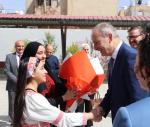You are here
A new financing pact for climate-vulnerable countries
Sep 10,2023 - Last updated at Sep 10,2023
By Ken Ofori-Atta and Axel van Trotsenburg
NAIROBI — Amid an escalating climate emergency and a global debt crisis, calls for a new “fit for climate” global financial architecture are growing louder throughout the developing world. The urgent need for decisive action has been underscored by Barbadian Prime Minister Mia Mottley’s Bridgetown Initiative, the V20 group of climate-vulnerable countries, and the recent Paris Summit for a New Global Financing Pact. This week’s Africa Climate Summit in Nairobi presented a unique opportunity to promote much-needed measures to support low-income countries in pursuing sustainable growth.
The situation is particularly urgent in Africa. According to recent estimates by the African Development Bank (AfDB), the continent requires $2.8 trillion in climate financing between 2020 and 2030. But Africa currently receives only 3 per cent of global climate finance, of which just 14 per cent comes from the private sector. It is worth noting that the continent accounts for 3.8 per cent of global greenhouse-gas (GHG) emissions, while the Global North is responsible for 90 per cent.
But even though the world’s most vulnerable countries are bearing the brunt of a crisis they did not create, development-related climate financing has actually decreased, as has overall development aid to Africa. Preliminary 2022 figures show that flows of bilateral official development assistance (ODA) from OECD Development Assistance Committee members to Africa totaled $34 billion last year, a decline of 7.4 per cent in real terms compared to 2021. Meanwhile, total private market assets under management surged to $11.7 trillion in 2022, having increased at an annual rate of nearly 20 per cent since 2017.
Given the severity and urgency of the climate crisis, the international community must rally to devise and agree on concrete solutions ahead of November’s United Nations Climate Change Conference (COP28) in Dubai. To build resilience against inevitable climate shocks, we must fully fund the “loss and damage” fund global leaders agreed to establish at last year’s COP27 in Egypt, agree to double funding for adaptation efforts, and apply the “polluter pays” principle to maritime activities.
To reduce GHG emissions and mitigate the worst effects of climate change will require mobilising financial resources on an unprecedented scale. But the proposals currently circulating among global policymakers lack focus. In the face of the greatest challenge to human survivability, we risk getting trapped, like Sisyphus, in a cycle of futile, incremental actions. In the lead-up to COP28, we must focus on a few essential steps that could spur global climate action and help limit global warming to the internationally agreed target of 1.5°C.
First, we must tackle Africa’s debt problem. The international community must support vulnerable developing countries grappling with debt crises and enable them to invest in climate adaptation, resilience, and sustainable development. To achieve debt sustainability, developing countries must diversify their economies, negotiate debt-restructuring deals, and ensure transparent and accountable governance. Developed countries and global financial institutions, especially the 550 members of the Glasgow Financial Alliance for Net Zero, could support these efforts by providing concessional financing for climate-adaptation policies.
Second, ongoing efforts to reform the system of multilateral development banks, including the World Bank’s “Evolution Roadmap” initiative, could enable MDBs to assist developing countries at the speed and scale necessary to meet global development goals and address challenges such as climate change, energy access, and pandemic preparedness. These reforms should also seek to direct resources toward regional lenders such as the AfDB and the Inter-American Development Bank.
Third, significant investments should be redirected toward the green transition, with a particular focus on expanding climate-vulnerable countries’ access to renewable energy. To this end, African governments could initiate regional programmes to harness their natural resources to produce clean energy.
Lastly, the International Development Association, the World Bank’s soft-loan facility, has emerged as a crucial tool capable of delivering the level of support Africa requires. The IDA already serves as Africa’s primary source of concessional financing, and African countries account for 75 per cent of IDA commitments totaling $34.2 billion, or $25.8 billion, in the fiscal year ending June 30, 2023.
Apart from being familiar to and trusted by governments across the continent, the IDA effectively amplifies donor contributions, a particularly valuable feature at a time when donor countries are fiscally constrained. We hope that the G20 and the Paris Summit’s call for an ambitious IDA replenishment will translate into substantial support aimed at addressing the challenges facing beneficiary countries.
Despite the massive challenges ahead, establishing a new climate-ready global financial architecture remains feasible. By working together and ensuring that all countries pay their fair share, the international community could bridge political divides and achieve tangible progress toward ensuring a habitable world. But to do this, we must maintain the current momentum until we reach our goal: enabling climate-vulnerable countries to achieve sustainable, resilient growth.
Ken Ofori-Atta, minister of finance for the Republic of Ghana, is chair of the V20. Axel van Trotsenburg is senior managing director of Development Policy and Partnerships at the World Bank. Copyright: Project Syndicate, 2023. www.project-syndicate.org












